Authentic Polish Pierogi with Potatoes and Cheese (Pierogi Ruskie)
This post may contain affiliate links which won’t change your price but will share some commission.
These Authentic Polish Pierogi with Potatoes and Cheese (Pierogi Ruskie) are the real deal. Traditional Polish dish at its best! Try this recipe and never buy pierogi again. They are amazing.
This post was originally published on December 24, 2014 (On Christmas Eve!) and since then has been updated to provide additional information.
You can also learn how to make Sauerkraut and Mushroom Pierogi from Scratch here or if you prefer a more creative version of pierogi try these Roasted Butternut Squash and Feta Pierogi.
This post may contain affiliate links. You can read my disclosure policy HERE.
Polish Pierogi with Potatoes and Cheese (Pierogi Ruskie) – the Most Popular Kind
Have you ever tried real, authentic Polish pierogi?
Now I’m not talking about the frozen dish that you can purchase in almost every supermarket. In fact, these store-bought cousins are even improperly named. They’re called “Pierogies.”
For all Poles, this is the funniest thing ever. The reason being is that the word “Pierogi” is already pluralized (1 “pierog” is the singular). The addition of an “s” to make the English name plural is just way too funny. But obviously, I get it, and I’m absolutely not offended.
Actually, it makes me proud that we have created a dish so popular that is eaten throughout the world. So, if you haven’t tried a truly authentic version yet, then definitely give these a go. ‘Street-cred’ affirmation: I am 100% Polish, born and raised in Wroclaw, Poland, and I make pierogi every year. These are the real deal :)
Authentic Polish Pierogi Served on Christmas Eve
As I mentioned I make this type of Authentic Polish Pierogi every year….for Christmas. However, these aren’t the only variety out there; I also make pierogi with sauerkraut and mushrooms – which are far more typical for Christmas in Polish homes.
Yet, Pierogi with Potatoes and Cheese (Pierogi Ruskie) are also very popular and often cooked in Polish homes. So, long story short, I brought this culinary tradition with me to the US and every year I devote either a day or 2 to making my favorite Polish dishes for Christmas.
In an effort to perpetuate these traditions, I’ve been indoctrinating my new family (my husband and my in-laws) by annually hosting a Christmas Eve dinner. And while this effort to cultivate their palates to the full spectrum of my Polish Christmas menu at first was met with baby steps, I can honestly say that they’re all in full stride now.
Staples of this Christmas menu include:
- 2 kinds of pierogi (with potatoes and cheese and with sauerkraut and mushrooms),
- Red borsch (a clear beet soup) with uszka (ear pierogi),
- Bigos ( Polish Hunter’s stew) or Kapusta (Sauerkraut with Mushrooms),
- fish “Greek style” (funny that it’s dubbed ‘Greek’ because it’s a very Polish dish), and
- Salatka (a root vegetable/potato/egg salad to die for, also known as Russian Salad) or Polish Potato and Egg Salad with Pickles.
While I could do more, I’ve decided to limit it and still enjoy the process of cooking and sharing with my family.
Now that we have Gabe and Aiden, who are growing up way too fast (sorry for the cliche gang, but it’s true), who are half Polish, I really want them to experience some of Mommy’s, and therefore their own, traditions. So I try to supplement their diet with Polish dishes whenever I can. My older one really loves Polish Dill Pickle Soup!
Polish Christmas Traditions
As long as I’m talking about traditions I’d like to give you a little glimpse of how a Polish Christmas looked for me when I was growing up. Obviously, I’m saying “for me” because I know that almost every home had its own little differences.
In fact, I know that as some of my Polish friends read this post they’ll be saying that this or that looked different in their houses. For instance, there was a clear divide between the soup served. I’m aware that people either had borsch (my house) or mushroom soup. With that said, there were some hybrid houses that had both soups served.
And recently I found out that there was yet another type of soup gracing Christmas tables…sauerkraut and mushroom. These variations seemed to run with geographic regions (like Red & Blue states). So, as this one example attests, different parts of Poland had different traditions; but I can tell you that there were some universals for all Poles.
Christmas Eve dinner always kicked off the holidays. Dinner was served after the first star showed up in the sky and consisted of 12 dishes. However, atypical of most Polish meals, meat was prohibited from the Christmas Eve table. Rather, the ingredients which dominated tables were: fish, pierogi, mushrooms, sauerkraut, and cabbage.
The common dishes served on Christmas Eve would be:
- borsch with mushroom mini pierogi (kind of like a ravioli), mushroom soup,
- different varieties of pierogi (the most popular being with mushrooms and sauerkraut and pierogi ruskie),
- bigos without meat (hunter’s stew – sauerkraut with mushrooms, plums, tomatoes) or just sauerkraut with mushrooms,
- fish – Hearings served in different sauces, and the most popular being Karp. My family wasn’t a huge fan of Karp because it was so boney and therefore my mom always went with Trout. Our go-to was a whole trout stuffed with lemon and butter (OMG!).
I don’t know if you’re familiar with our Polish Karp tradition, but it seems to me that a number of people around the world have a vague familiarity with it, as I was asked about it a few times.
Anyhow if were to visit any community in Poland right before Christmas, you would find places everywhere selling “Live Karp.” As a kid, my own appreciation of this was that everyone was taking Karps home and letting them swim in the tub (cool right? a pet!). I knew nothing more than that. To this day I still question where these glorious pets would vanish to.
How to make Polish Pierogi Ruskie
But I digress, Pierogi are a different story. I always know where they start, and where they end. They start with potatoes, cheese, onions, spices, and with flour for the dough. I roll it, cut it into little round cutouts, insert a little ball of potatoes/cheese mixture, seal it, and there you go.
But let’s take it one step at a time (for exact measurements, instructions and nutritional information scroll down to a printable recipe):
Prepare the pierogi ruskie filling:
Step 1; Boil your starchy potatoes (medium yellow potatoes or russet potatoes) with salted water; drain, and mash either using a potato ricer or potato masher;
Step 2: In a frying pan, heat up some butter, oil, or ghee and fry up onions until almost brown (they will add a ton of flavor to the filling;
Step 3: Add framer cheese into the potatoes and mix well;
Step 4: Add fried onions, other cheeses, and spices to the potatoes/cheese mixture and mix well. Set the filling aside (The addition of blue cheese and cheddar is something new to me. It’s a simple trick from a very famous Polish chef. I tried it and it really elevates this dish to another level).
Prepare the pierogi dough:
Step 1: Pour the flour on a counter or other surface that will allow you to make the dough, add a pinch of salt, make a little hole in the middle and start adding milk and butter, add a little water at a time and work the dough until you can form a ball about 10-15 minutes; (Some people use egg for the dough. I tried all kinds of dough variations and in my opinion, mine is the most delicate. Egg tends to make the dough tougher. You can add an egg to the dough and reduce the amount of liquid).
Step 2: Once done, cover it with the big bowl and let it rest for about 20-30 minutes
Step 3: Roll the dough until thin (like pasta) and using either a cookie cutter or a large wine glass cut the circles; place 1 teaspoon of the fling in the middle of the circle, wet one half of the circle, and then seal it together;
Step 4: Boil a large pot of water and season with salt; once the water is boiling put about 8 pierogi at a time; once they come to the surface let them cook for 1 minute and using a spider or slotted spoon take them out on a plate;
Step 5: OPTIONAL: If you want to fry them as I did here, use 1 tablespoon of oil or ghee and fry pierogi on each side until golden brown. It’s best to dry them first before frying so they don’t splash.
For the pierogi toppings:
While this tradition mentioned above is alive, I no longer abide by the “no meat” on Christmas Eve mandate. So, often I sprinkle my pierogi with a little bit of chopped bacon, and likewise, I use sausage in my hunter’s stew. But I know that a lot of people are still very strict about this requirement.
Anyhow, the addition of meat is purely optional. For the featured version here of Authentic Polish pierogi, I did go with some chopped bacon.
-
Using separate pans add oil and onions and fry the onions until golden brown and bacon until crispy (you don’t need fat for bacon as it is already fatty);
-
Add onions and bacon on top of the pierogi and serve with sour cream.
Storing and freezing pierogi
If you are not serving pierogi immediately, take them out on a counter and let them cool down and dry a little bit. Make sure that they are not touching each other.
Once cooled, place them on a baking sheet, again at distance from each other, place them in a freezer and let them freeze. Once done, you can pack them in a plastic bag.
Now, I won’t lie here. When you’re new to the Pierogi-making business it can take a while to master them. Admittedly, they seem so easy, but when you get to the point where they have to be sealed, a lot of times you’ll find that they aren’t very cooperative. But practice makes perfect. It used to take me hours from start to finish.
Now I can be done in 2 hours with about 80 Pierogi – ready to serve. So, if you have the patience to learn how to make them, then go ahead and give them a try. Just don’t get discouraged the first time out. Even if it takes time, I can guarantee that they will taste delicious and you’ll be so proud of yourself that you will want to tell the whole world about them and the work you’ve done.
How to Alter this Recipe for Authentic Polish Pierogi:
- As mentioned above you can add an egg to your dough.
- I usually have no problem finding farmer cheese in local supermarkets in N.Y. but I know that it may be difficult to find. You can either buy Framer cheese on Amazon or use whole milk large curd cottage cheese (about 8 oz. but be careful because this cheese is more watery so your filling may become a little too soft);
- I added a little cheddar and blue cheese but they can be omitted;
- They can be served boiled or fried with just fried onions.
If you’re looking for more Polish recipes here are a couple of suggestions:
- Dill Pickle Soup – Traditional Polish Recipe
- Pierogi with Sauerkraut and Mushrooms from scratch:
- Kapusta – Sauerkraut with Mushrooms
- Cabbage and Kielbasa
- Bigos – Polish Hunter Stew
- Roasted Butternut Squash Feta Pierogi
- Polish Cucumber Salad – Mizeria
- Polish Fluffy Apple Pancakes
- Breton Beans (Fasolka po Bretonsku)
- Creamy Mushroom Sauce
I guess I’ve waited a lifetime to say, ‘hey world, here are Pierogi!!!!’ Without further adieu, I give you my super delicious Authentic Polish Pierogi with Potatoes and Cheese. Cheers!
And if you want to finish your dinner with some delicious treats, these Traditional Czech Linzer Cookies will be your new favourite.

Authentic Polish Pierogi with Potatoes and Cheese Recipe
Ingredients
For the filling:
- 5 Potatoes yellow, medium or 3 large russet potatoes
- 8 oz Farmer cheese
- 1 tablespoon Blue cheese (optional)
- 2 tablespoon Cheddar cheese (optional)
- 1 Onion sweet, yellow, large, chopped
- 1/2 teaspoon Garlic powder
- 1/2 teaspoon Onion powder
- 1 tablespoon Oil or ghee for onion
- Kosher salt and freshly ground black pepper to taste
For the dough:
- 3 cups Whole purpose flour
- 1/2 cup Milk 2%, warm
- 1/2 to 3/4 cup Warm water (depending on how much your flour soaks)
- 1 tablespoon Butter melted, unsalted
- A little bit of kosher salt
For the toppings
- 1 Onion large, yellow, chopped
- 3 slabs Bacon chopped (optional)
- 1/2 cup Sour cream
- 2 tablespoon Oil or ghee for frying
Instructions
For the filling:
- Place potatoes in a pot, cover with water and cook until fork tender;
- In the meantime heat up the oil or ghee in a frying pan, add onions, and cook until golden brown;
- Once potatoes are cooked, using a potato ricer or potato masher, mashed potatoes so they don't have lumps;
- Add farmer cheese and mix together;
- Add onions, other cheeses, spices, salt, and pepper and mix well.
For the dough:
- Pour the flour on a counter or other surface that will allow you to make the dough;
- Add a pinch of salt;
- Make a little hole in the middle and start adding milk and butter;
- Add a little water at a time and work the dough until you can form a ball about 10-15 minutes;
- Once done, cover it with the big bowl and let it rest for about 20-30 minutes;
- Roll the dough until thin (like pasta) and using either a cookie cutter or a large wine glass cut the circles;
- Place 1 teaspoon of the filling in the middle of the circle;
- Wet one half of the circle and then seal it together;
- Boil a large pot of water and season with salt;
- Once the water is boiling put about 8 pierogi at a time;
- Once they come to the surface let them cook for 1 minute and using a spider or slotted spoon take them out on a plate;
- If you want to fry them as I did here, use 1 tablespoon of oil or ghee and fry pierogi on each side until golden brown;
For the toppings:
- Using separate pans add oil and onions and fry the onions until golden brown and bacon until crispy (you don't need fat for bacon as it is already fatty);
- Add onions and bacon on top of the pierogi and serve with sour cream.
Notes
2. Addition of blue cheese and cheddar is something new to me. It's a simple trick from a very famous Polish chef. I tried it and it really elevates this dish to another level.
3. If you are not serving pierogi immediately, take them out on a counter and let them cool down and dry a little bit. Make sure that they are not touching each other. Once cooled, place them on a baking sheet, again at distance from each other, place in a freezer, and let them freeze. Once done, you can pack them in a plastic bag.
Nutrition
PIN IT for later:
Read about the author Edyta here or follow Eating European on social media: Facebook, Instagram, Pinterest, and Twitter.



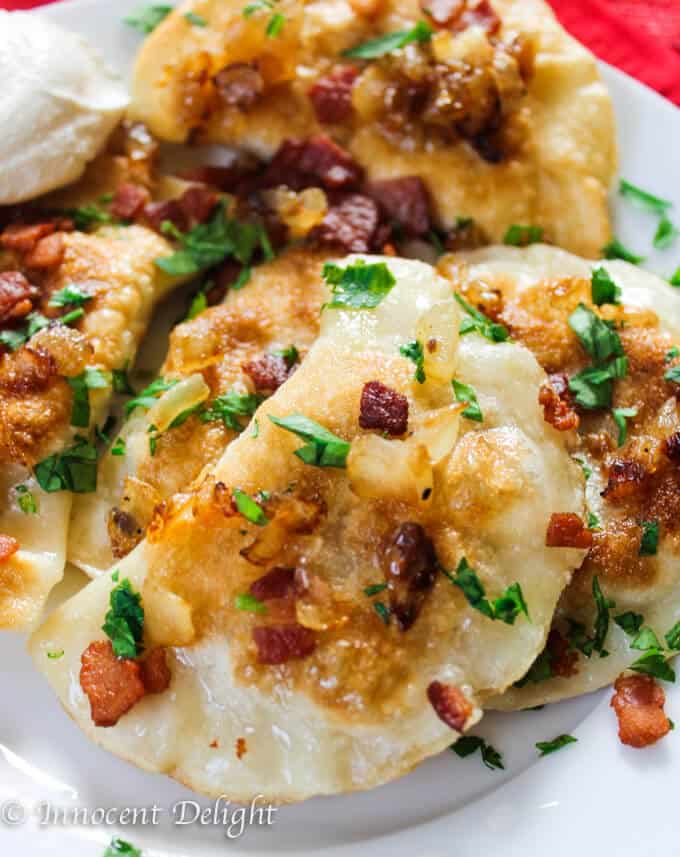
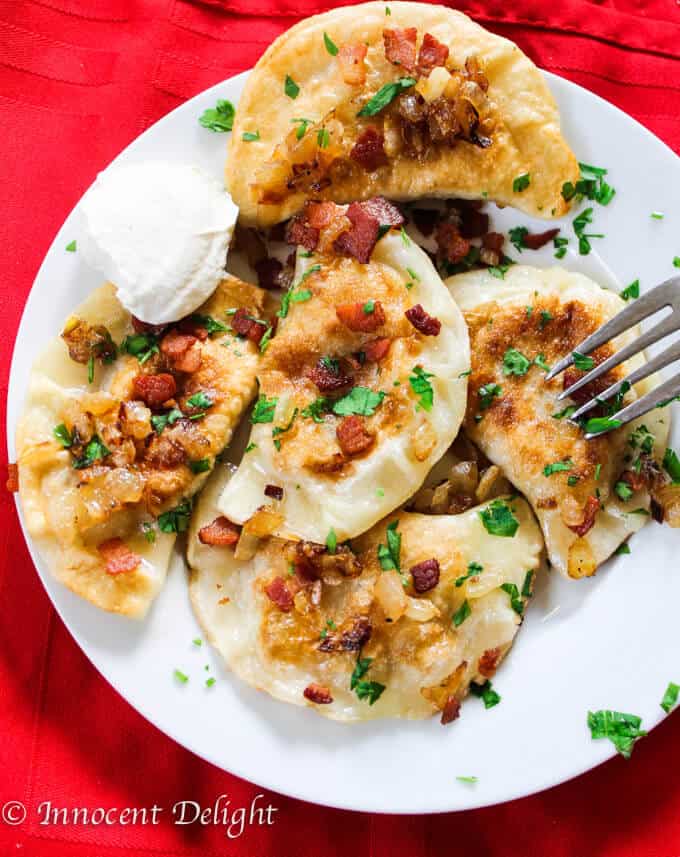
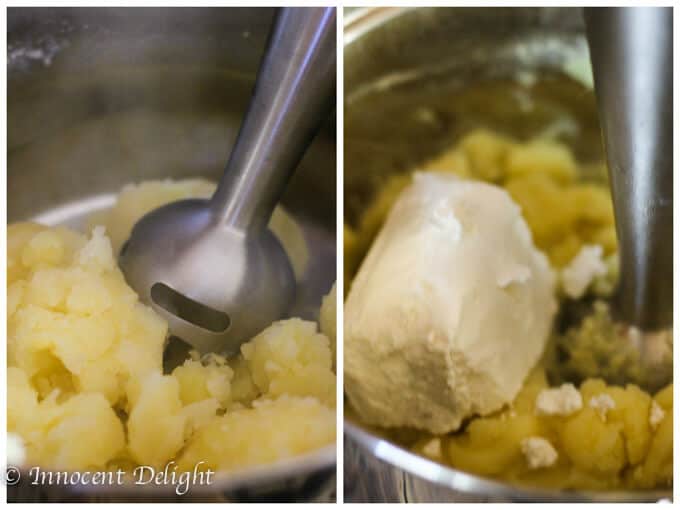

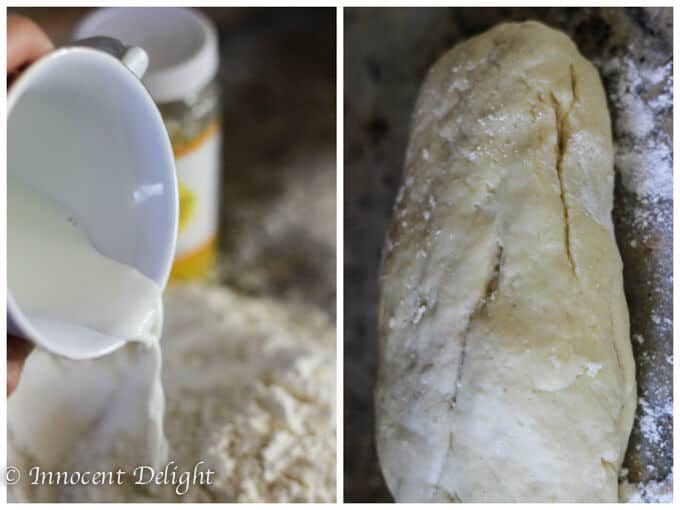
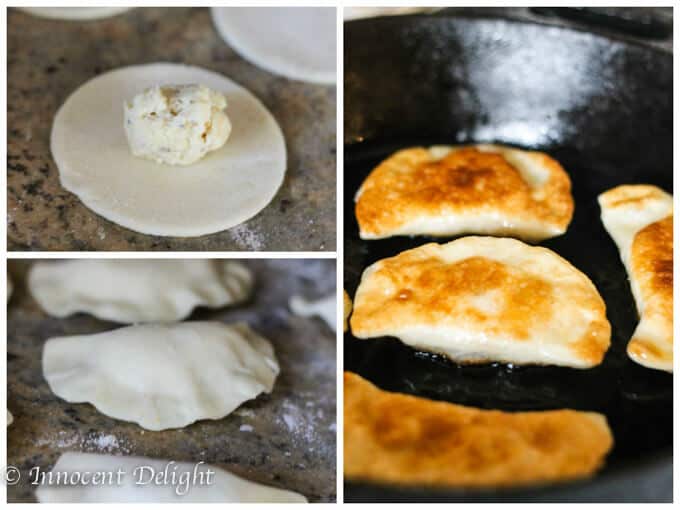





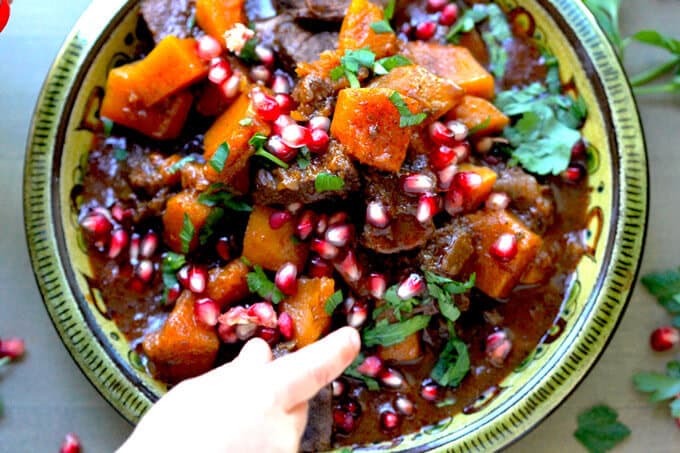
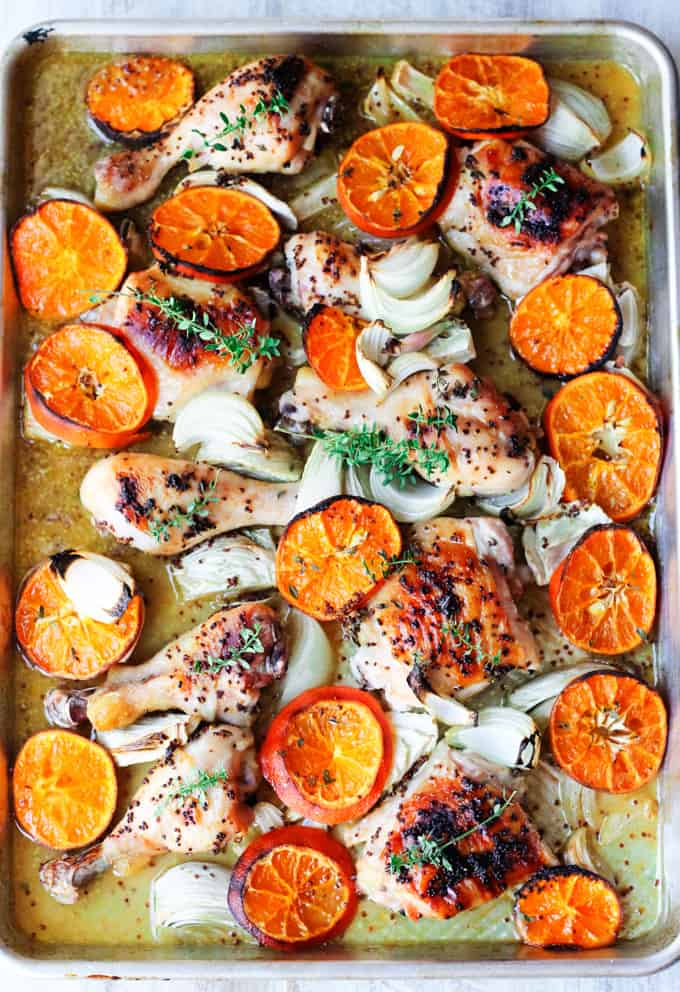
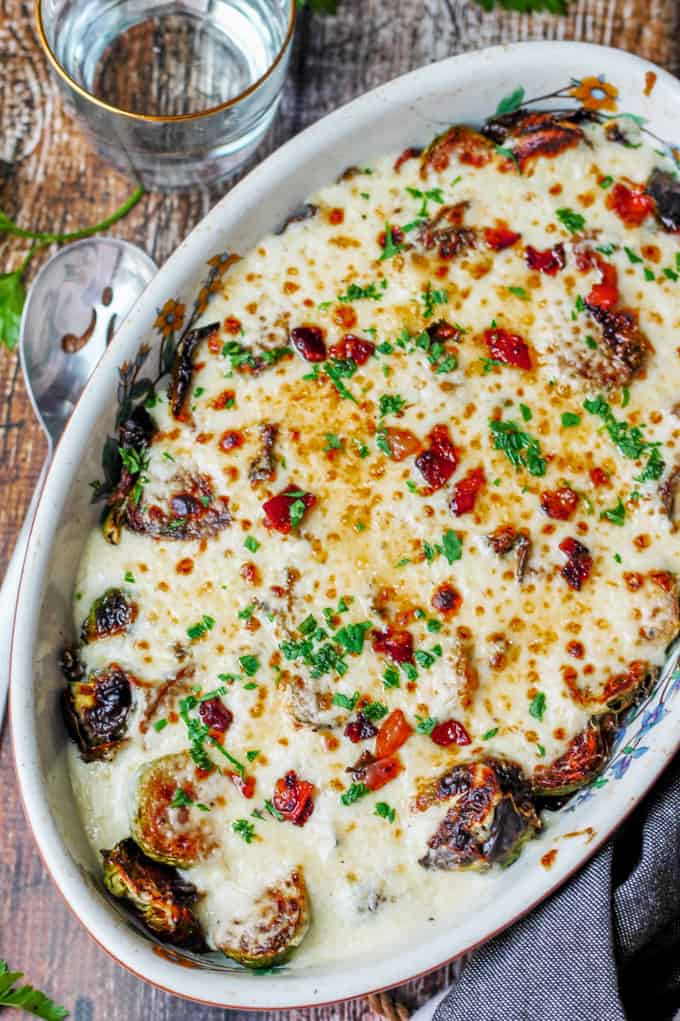
this plate looks beautiful, I will try this recipe. Thanks
Thanks so much!
I am really looking forward to easter dinner. I think your recipe will be a hit for my family. Thank you formsharing
Thanks for checking my recipe Tracey.
This looks wonderful, my father’s people immigrated from Hungary and ate similar dishes. I will give your recipe a try, the dough does looks very delicate. Thank you for sharing.
Thanks for stopping by Joanna. I hope you will like them. 🙂
I make homemade pierogi every year with a small gaggle of Polish friends who remember the dish fondly from their childhoods. My recipe is passed down from my grandmother and Aunt, both Polish immigrants and it varies a little from this. Of course, each of the women who joins in this undertaking every December all have recipes that vary from mine and yours, as well. In fact, I have not met any two that make it the same way, but all have been delicious and the fundamentals of potato, cheese, and sauerkraut are present in everyone’s dishes. Thank you for adding another variation to mix and I look forward to introducing this version to our troupe next year!
Hi Laurie, thanks for sharing your pierogi story and I agree almost every woman makes a little variation. There are differences in dough and in filling. I tried different types of dough and sticked to this one for the last couple of years but it is personal preference. As for the filling it was the first time ever that I added different cheeses on top of the farmer’s cheese and my family said that these pirogi were the best I have ever made. So maybe it made a difference or maybe they already forgot that one year ago they were equally delicious :). I’m happy to hear that you want to try it with your troupe next year! 🙂
What is whole purpose flour?
Regular flour that you can use for any kind of baking.
I will try these for my husband. He loves pierogi. But he also loves Bigos (Hunters Stew) we’ve never found a recipe that tastes like he had years ago. Can you share a recipe for it with me?
Thank you so much.
Thanks Ann! I will definitely put Hunter’s stew on my list to post. For now you can check my recipe for Sauerkraut and Mushrooms and to make bigoes I normally add to this recipe tomato paste, prunes, red wine, onions, bigos seasoning (found in Polish deli), and sautéed sausage and I cook it for a couple of hours. Email me at edyta(at)innocentdelight.(com) if you need exact recipe and I will send it to you.
Greetings from a fellow Pole in the UK. These look absolutely wonderful! And yes, very authentic. All the best for the new year.
Thanks Ren! I’m glad you stopped by 🙂
I’m so glad you posted your recipe. I celebrate Christmas Eve with my ukrainian family, so we have borscht and boiled petahe. I can’t wait to try your pierogi recipe (even though I’ll still secretly call them petahe haha)
Hi Kate! Thanks so much for stopping by. Let me know how they came out for you 🙂
I am Ukrainian and grew up eating pierogi, aka petahe . I had no idea how that word was spelled, My grandmother cooked them for us and luckily we never limited them to just Christmas time but enjoyed them all year . She also cooked cabbage rolls and city chicken, not really chicken at all. Still some of my favorite foods.
Hi Cynthia! Thanks for stopping by. It’s wonderful that we can share the traditions 🙂
I am also Ukrainian (1/2) and have fond memories of learning how to make petahe when young enough to have to stand on a chair at the table when “helping” mix the dough. We made petahe and cabbage rolls frequently, with my grandmother also using grape leaves for rolling, We had occasional borcsht, some kind of liver pate’ and (pig’s) head cheese as well. I am curious if people who make cabbage rolls with tomato sauce are more Germanic in heritage as ours weren’t prepared that way.
Hi Cheryl, thanks for stopping by. To be quite honest I don’t know where the tomatoes sauce on stuffed cabbage came from. Since I was a little girl I always thought it was Polish 🙂
OMG… I love you for showing us how to make these yummy little morsels.
They are one of my favorite things and I love to eat them with my homemade
warmed up bacon jam.
Wish you were close by so you could give me a private lesson. I would love to hear
all about your home country while you whipped these up. Reading your post was
almost the same!! Your husband and in-laws are quite lucky!!
Wow, Kimberly, this is the nicest comment I have ever gotten. Thank you so much! It would be my absolute pleasure to make pierogi with you 🙂
I loved reading about your yummy pierogi. I grew up in a second generation polish immigrant family and Christmas Eve was a meatless meal filled with fish, mushrooms , kapusta and all the wonderful foods that my Mother learned from her Grandmother and Mother and taught my sisters. And I. Keep sharing those wonderful recipes on your blog.
Thanks Janice. I will do my best to share more traditional Polish recipes. Thanks so much for visiting my blog. It means a lot that Polish descent is my reader and that we have common traditions. All the best in 2015! 🙂
Thank you for sharing !! Our family shared almost the same traditions as you on Christmas Eve. My mother spent many days leading up to Christmas making her delicious pierogi, borsch,kapusta. We were spoiled with blueberryy ,potato & cheese & sauerkraut filled pierogi. Golomki were another favorite for Sunday dinners! I have mastered the golomki and you have inspired me to do the same with the pierogi. My Mother would be delighted!
Awesome Lisa! Let me know how they came out for you 🙂
I made these today – it’s a cold, snowy day in Munich – and they are perfect. Lots in the freezer to have another day as well. Thanks for sharing this!!
Thanks for checking my blog from Munich! That’s so wonderful. I’m glad you made these pierogi 🙂
Ty for taking all your time to share this wonderful recipe with us out here in blog land. I have no Polish blood in me, but grew up with a good friend who was, and every Saturday, her grama who lived with them, made pierogi. As kids, being given one of these treats, we felt so lucky. Now , we live in St Louis, and I haven’t found a place that makes a pierogi like i remember from my childhood. Our son has married and lives in Columbia MO, now and we have found a very small restaurant there that serves pierogi, that are to die for. That is just about all they serve there, but several different flavors. We feel so lucky to have the authentic family run Polish restaurant with the real deal Polish food. So many wonderful blend of different countries, with so many great family memories. Love all these stories on your blog. Please keep them coming.
Dianna, thanks so much for such a nice comment. It’s so good to hear that someone is enjoying my stories 🙂 If you are ever in NY I can recommend a Polish restaurant with amazing pierogi!
Muito bom ver pessoas que gostam dessas receitas polaca, mas na minha familia pirogi se chama varenick!
Thanks for stopping by!
Thank you for your post! I am polish and make pierogi for Christmas Vigilia dinner. We also have Borsch at that dinner as well! I loved reading your post- we are lucky to share such wonderful recipes with our children!
Thanks Teri! Yes, we are lucky with these wonderful Polish dishes! 🙂
These tasted amazing and were pretty easy to make! I really liked the dough and will probably use it to make other types of pasta. Thanks for sharing!
Thanks so much Jaime! I’m so happy you liked them 🙂
Thank you for this post! I’ve tried several different doughs, one using sour cream. I plan to try your recipe when I make these next week. Besides Christmas, I host a “Polish St. Patrick’s Day” party in March every year for my family where we all eat Polish food, and enjoy spending time together.
Beverly, thanks so much for stopping by. Please let me know how they came out for you 🙂
Edyta,
After I make these, can I put them in the fridge overnight until I fry them the next day?
Beverly, yes you can put them to the fridge but you have to melt the butter and cover them well so they don’t stick together. Otherwise they may stick and the dough can fall apart.
Hi Edyta,
Thank you for posting this recipe, it looks absolutely delicious! I can’t wait to make these for my family. Just a quick question, I was wondering what is farmer’s cheese?
Hey Rachel, thanks for checking my recipe. Farmer’s cheese is a white cheese, that is soft, sort of like ricotta but a little bit more firm and sour. You can buy Farmer’s cheese in any grocery store. I’m sure that if you ask for help the staff will be able to show you where to find it.
My first homemade pierogi and they were delicious. I did have about twice the amount of filling than what was needed and wondered if I didn’t use the right technique for filling.
Mary, sometimes it may happen, if your flour was absorbing more moisture and you didn’t get a lot of dough. In those instances I sometimes freeze leftovers or make another batch the next day. 🙂
This is a great recipe, and I especially appreciated your comments on eggs. I followed your instructions and the dough was perfectly soft, and after resting at room temp, was perfect for rolling.
I’m so happy to hear it Katie. Thanks for trying my recipe 🙂
my mother was from Poland. Her pierogi were always made with mince inside. I can’t remember what kind, maybe a mix of beef and pork or lamb. It was mixed with grated onion, garlic, pepper, salt and dill. She used dill in her cooking a lot! Lol. They were served with cooked bacon bits like yours, and boiled only. She never fried them. She’s passed now ?. I miss her pierogi so very much ?
Hi Kristina, this is such a touching message. I can imagine how much you must miss your mother. Pierogi that you described are actually very popular in Poland. There are 3 main kinds: with potatoes and cheese, sauerkraut and mushrooms, and minced meat. They can be served boiled or fried. I’m hoping to post more Polish dishes on a blog. I will definitely make pierogi with meat one day. Thanks so much for stopping by and your kind comment.
I want to make the meat one so bad!! Do you have a recipe I can follow because when I was in Poland I fell in love with the meat one.
Hi Jennifer. I don’t have a meat recipe now. I see if I can find one for you. I will try to make one for the blog as well 🙂
Your meabs of describing all in this piece of writing is genuinely pleasant, every onne be able
to without difficulty know it, Thanks a lot.
Thanks so much Janna!
Yoou actually make it appear really easy along with your presentation however I find this matrter to be really something that I believe I might
never understand. It seems tooo complex and extremely huge for
me.I am having a look ahead to your subsequent post, I will attempt to get the hang of it!
It’s definitely time consuming and requires some practice. But I can assure you that it will gets easier when you do it a few times 🙂
Loved your recipe. My dad learned how to make perogi from his Polish neighbors when he was young. His mom passed when he was little so he helped with kitchen duties (makes the best bread and cinnamon rolls ever) . He taught my mom and I have sweet memories of spending a day with her making perogi. Glad to see you pan frying them. Never thought to add bacon, so now mine will have a little twist too.
Hey Debra, thanks for checking my recipe. Trust me this twist will take the pierogi to the whole another level. Enjoy 🙂
My husbands family is Polish and this is my first attempt at making Pierogi from scratch. Babcza doesn’t have the dough recipe written down anywhere so thank you for posting your recipe. I hope that mine turn out as beautiful as yours look.
Thanks Patricia,let me know how you liked them 🙂